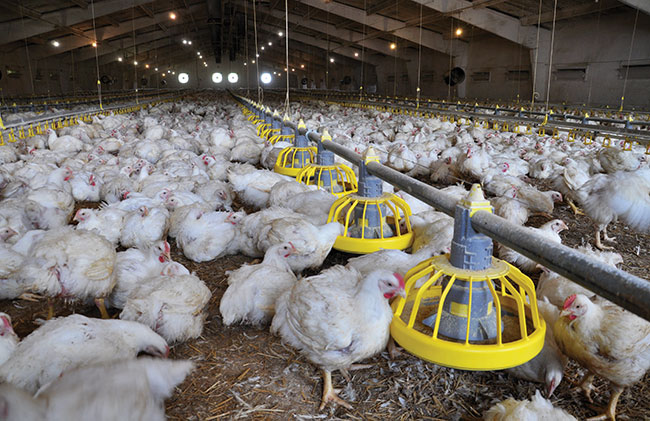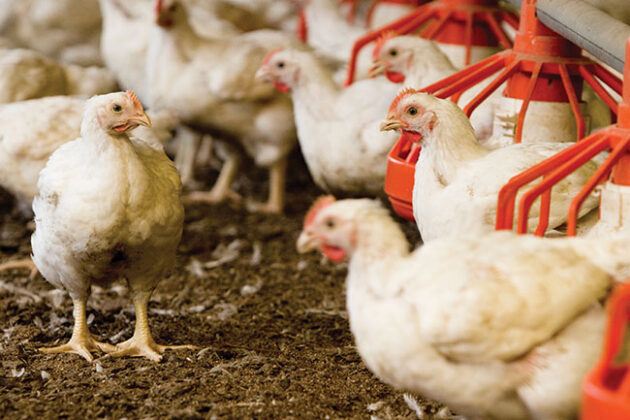
Preventing heat stress in broilers
By Brendan Graaf
Features Barn Management Bird ManagementKnowing how to mitigate the adverse effects of heat stress on broilers helps maintain high production performance. This article outlines some key concepts and practical tips.
 Walk slowly and gently through the broiler house to encourage birds to stand, which will help release body heat and cool the birds.
Photo: Cobb-Vantress
Walk slowly and gently through the broiler house to encourage birds to stand, which will help release body heat and cool the birds.
Photo: Cobb-Vantress Knowing how to mitigate the adverse effects of heat stress on broiler performance helps maintain high production performance and ensures good welfare during periods of hot weather. In this article, we will outline some key concepts and provide some practical tips to mitigate heat stress.
Careful planning is fundamental, whether you live in a hot weather region and deal with heat stress on a regular basis or live in a cold weather region and only experience seasonal periods of heat stress.
Keeping up to date with local weather and knowing when heat stress may be a possibility, allows proactive adjust to management practices to keep birds healthy.
Ventilation
One tip is to increase ventilation rates earlier in the morning. Keeping birds cool during this period will allow them to cope better during the peak midday heat.
Secondly, birds will carry heat from the day late into the evening, so maintaining higher ventilation rates for longer and later into the evening, even after house temperatures have returned to set point, will help reduce heat stress.
It turns out, if birds are kept birds cool during the evening, they are more able to deal with heat stress the following day. If you have back-to-back hot days, it is worthwhile to lower set-point temperatures during the evening and ventilate more.
When it comes to reducing bird effective temperature and alleviating heat stress, being able to achieve wind speed across the birds is huge. This is easily achievable if you have a well-designed tunnel ventilated house.
Ensuring that your house is ventilating at maximum capacity and is creating as much air movement at bird level during hot weather will significantly help alleviate any heat stress on the birds.
Managing house relative humidity (RH) during hot weather is also critical. Birds will lose heat through respiration and their ability to do so will be greatly affected by the RH of the air around them.
Evaporative cooling systems (cool pads or fogging systems) will reduce the ambient air temperature in the house; however, they will increase RH and thus reduce the bird’s ability to lose heat through respiration. As a rule, these systems should not be used when house RH levels are above 85 per cent.
Lighting Programs
When the lights go off in the evening (dark period), there may not be a reduction in house temperatures. However, it is now well known that bird body temperatures increase during the dark period. This creates a situation where an automatic controller set to reduce ventilation (due to a reduction in house temperatures) will cause the birds to produce more metabolic heat.
Be aware of this potential situation especially during hot weather periods and be prepared to override the controller systems to ensure sufficient ventilation longer and later into the evening.
It is also important to ensure that the temperature and relative humidity (RH) probes are set at the right heights, just above bird height. They sensors should be high enough that birds cannot play with them, but that sensors low enough to accurately measure the temperature and RH the birds are experiencing.
With regards to the lighting program, during hot weather, it is better to set the lights off time to later in the evening. This will allow the birds more time to cool off from the hot day as well as more time to compensate on feed intake that they may have missed during the heat of the day.
The length of the dark period is also important. Longer solid blocks of dark (six to eight hours) will increase the potential for heat stressed birds. Therefore, breaking the dark period into shorter time frames (four hours) followed by a light period (two hours) and then another dark block (two hours) will help reduce heat stress.
It is important to note that the lights off time should be set from day 0 and not adjusted throughout the cycle so this needs to be planned and set in advance taking into consideration hot weather seasons.
Bird Body Heat
Although outside temperature is a major factor, generally the most heat being produced in a broiler house comes from the birds themselves. This is the heat ventilation systems need to remove from the birds and from the house to keep birds healthy.
Bird density plays a major role in body heat production. If you know your housing system struggles to keep birds comfortable and productive during the hot weather season, then reducing stocking densities during this period can prevent heat stress and promote good animal welfare outcomes.
Walking through the house gently to encourage bird activity can be highly beneficial since heat stressed birds tend to lie down and have significant heat buildup under their bodies in the litter. Getting birds to stand up and release heat will be beneficial.
Importantly, only encourage bird movement when the house is fully ventilated and there is air movement over the birds that can remove heat the birds and litter. Walk through the house slowly and gently to reduce bird flightiness. Walking slowly will also allow the birds around you to stand up for slightly longer before sitting back down again allowing more heat to be removed.

Reduce stock densities during hot weather seasons to help prevent heat buildup in the houses.
Photo: Cobb-Vantress
Feed and Water
Water and drinker line management during hot weather is very important to reduce heat stress. During periods of panting water is lost through the respiratory tract of the birds. In response, water intake is increased to maintain thermoregulation.
Therefore, ensure there is enough drinker space (10 to 12 birds/nipple) and that all drinker lines are working correctly and can supply enough water to the birds (correct flow rates/pressures). Maintain water temperatures below 25°C through regular flushing of drinker lines.
Making sure water storage/header tanks are shaded or kept indoors out of direct sun exposure will also help ensure cooler water delivery into the houses. Electrolytes and vitamins such as sodium bicarbonate, potassium chloride and vitamin C can be added to the water. However, this should be monitored closely to prevent any wet litter issues as well as biofilm formation in the drinker system.
Feed formulation and quality can also play a role in alleviating heat stress. The partial replacement of energy sources from carbohydrates to lipids is a common practice to reduce the heat increment of the diet as lipids generate less heat when they are digested and metabolized compared to
carbohydrates.
Since heat stress negatively affects feed intake, gut health and villi function, the use of lipids also has the benefit of slowing feed passage rate in the gut thus giving more time for nutrient absorption.
Since heat stress can impair digestive function, selection of protein sources that are high in digestible protein and amino acids as well as switching to supplemental/synthetic sources of amino acids can help improve digestibility and reduce heat production during digestion.
There is also an added benefit of being able to dose essential amino acids such as methionine and cysteine which play a role in the body’s antioxidant system. Broilers tend to generate more heat and use higher energy when eating a mash feed compared to a pelleted feed.
Good pellet quality with no more than 10 per cent to 15 per cent fines and a durability index higher than 95 per cent can reduce heat and energy used during eating.
Conclusions
Managing broilers through periods of heat stress is not only about keeping birds alive but keeping them comfortable and productive. Making sure to monitor your local weather and planning is the proactive way to successfully implement many of the above tips and will go a long way in ensuring a successfully broiler cycle.
Brendan Graaf is a broiler specialist with 10 years of experience in the poultry industry. He services the EMEA region. Brendan holds a Bachelor’s degree in Animal Science and a Master’s degree in Poultry Science.
Print this page